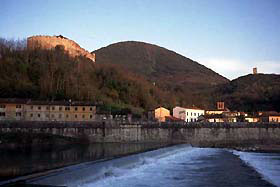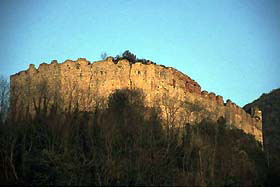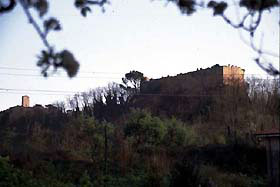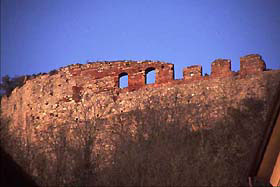Rocca of Ripafratta
 |
 |
| The River Serchio dominated by the Rocca and by the Mount Pisano. On the left one of the watch-towers that completed the fortifications. | |
The Rocca of Ripafratta is reachable, from Florence, following the highway A11 up to the exit of Lucca. From here we have to follow the indications for the SS12 of the 'Abetone' and go on it in direction Pisa (attention not to mistake following SS12bis). After about ten kilometers the mighty massive structure of the fortification will appear on our left.
According to the legend, confirmed by historical events, the town of Ripafratta owes its name to a breaking and consequent landslide happened to the slopes of the Mount Pisano that caused the deviation of the course of the river Serchio that before this event thrown into the river Arno at the height of the city of Bientina. (Ripa=riva in eglish shore and Fratta=rotta in english breaked)
 |
| The northern front with another watch-tower set to the slopes of the Mount Pisano. |
Thanks to its strategic position, at dominion of the course of the river Serchio in the most narrow point of the valley, along the forced passage between Pisa and Lucca, Ripafratta results to have been a fortified site under the dominion of Pisa since before the year 1000. The first documented clash under the walls of the castle between the Pisane and Lucchese armies is dated 1004. Well soon the fortress entered in the aims of Florence in whose hands fell for the first time in 1254. After the battle of Montaperti (1260) Ripafratta returned to Pisa; it surrendered again to Florence and in 1314, thanks to the works of strengthening carried on by Uguccione della Faggiola, returned to Pisa. The militias of Castruccio Castracani occupied the fortress that passed definitely to Florence conquered by the captain Guglielmo Altoviti. All these passages of hand let us understand the importance that in the Middle Age Ripafratta had. To confirmation of this in the 15th century the whole Rocca was completely restructured, to be suitable to the evolution of the fire weapons, by the big Medicean architect Giuliano da Sangallo. Made practically impregnable the fortress resisted to the Pisane attempts to free it from the Florentine control perpetuated between the 15th and 16th century .
 |
| Particular of the precarious walls of the strengthened enclosure. |
Still today we can realize the importance of the fortress, fulcrum of the vast defensive system of this delicate zone of border. Above the suburb rise the high curtain walls that contain the core of the fortification. The additions of the Sangallo are still well visible because, performed in bricks, they almost form a decoration in contrast with the dark stone of the preexisting construction. An only gate, still overhung by the coats of arms of the varied Pisane and Florentine Podesta (medieval term for chief magistrate or governor), conducts inside the inner ward where rises the scarce rests of the keep, once watch-tower and most ancient nucleus of the castle, today even visible from the outside of the building entourage. Always in the inside courtyard lies the ruins of the constable residence and the accesses to the underground and to the cisterns for the water. Others two angular towers, collapsed, close the defenses at east and west. Around the Fortress rise varied watch-towers of square form, one to the inside toward the Mount Pisano, another to east along the river, both still in good state, a third by now disappeared was at the bottom the fortress to direct control of the course of the river. A fourth tower is still visible on a hill on the opposite bank of the river Serchio.
Unfortunately all these fortifications lies in a serious state of abandon and they are at risk of ulterior collapse, over that for the action of the time and the nature, also for a series of yielding of the ground that interest the whole country, to confirmation of the truthfulness on the origin of its name! The road that conducts to the fortress is today closed for safety.
| Back to Homepage |
| Back to Castles Index |